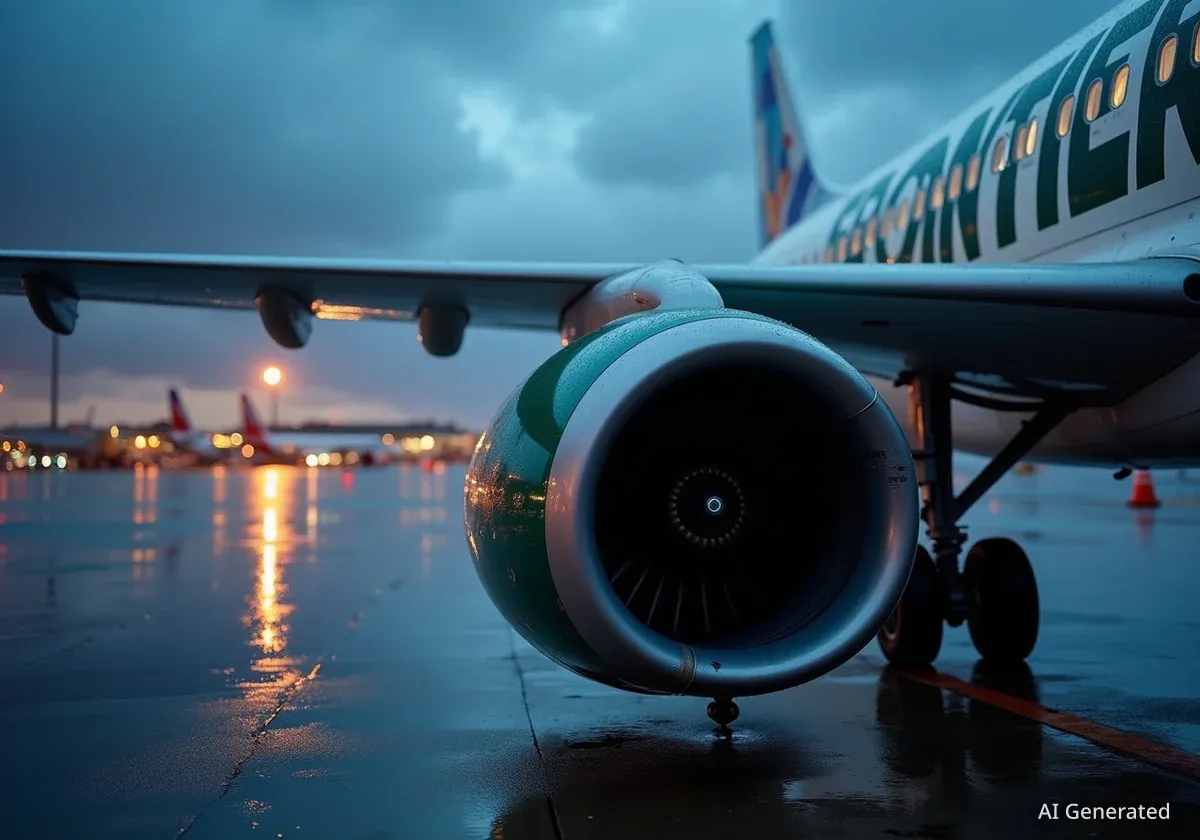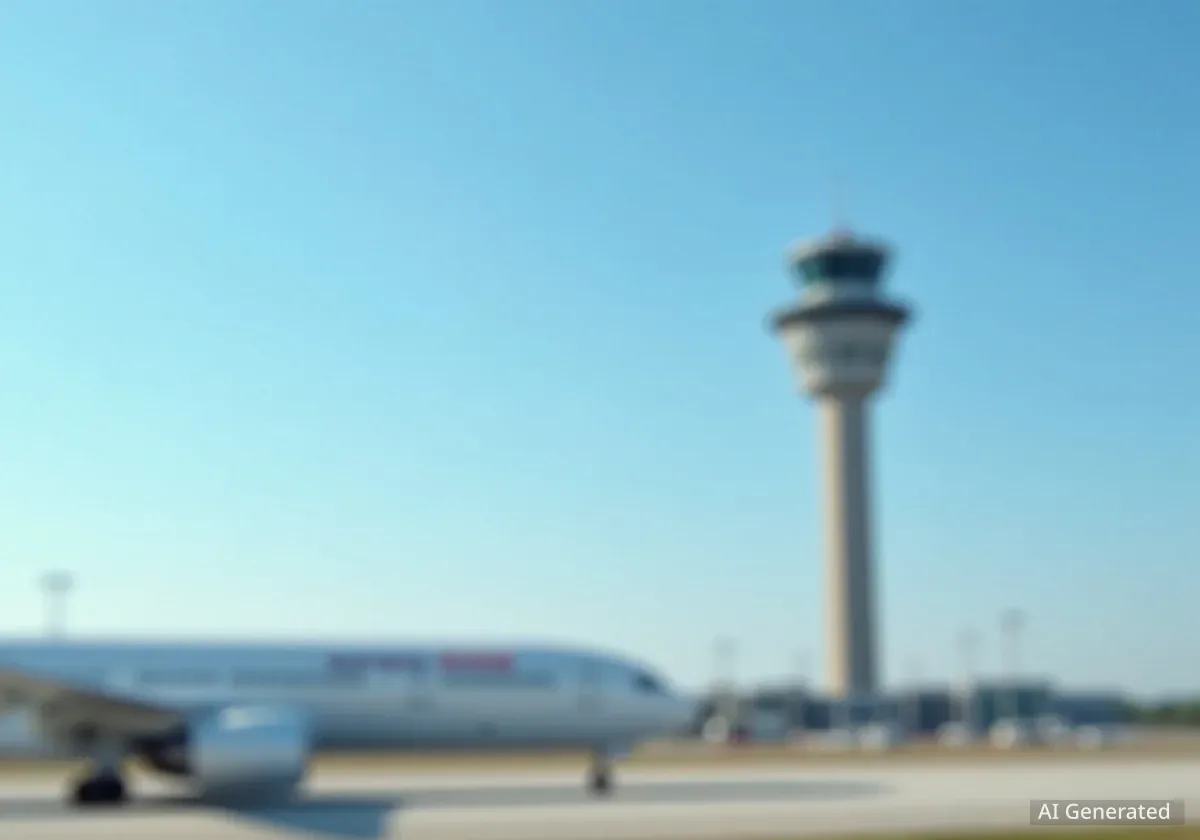A Frontier Airlines flight experienced an engine issue upon landing at John F. Kennedy International Airport (JFK) on Thursday, October 30, leading to a temporary ground stop for all incoming and outgoing flights. The Federal Aviation Administration (FAA) confirmed the incident, which occurred around 12:45 pm local time, and cited severe weather as an additional factor impacting airport operations.
Frontier Airlines Flight 3546, after reporting an engine problem, landed safely at JFK. Despite the safe landing, authorities initiated a ground stop as a precautionary measure. This action immediately raised concerns about significant delays and potential cancellations for numerous flights.
Key Takeaways
- Frontier Flight 3546 reported an engine issue upon landing at JFK.
- FAA issued a ground stop for all arrivals and departures at JFK.
- Severe weather and strong winds contributed to traffic management programs.
- Delays for arriving flights averaged over four hours.
- This incident followed a ground delay at Newark due to staffing issues.
Engine Issue Triggers Airport Halt
The crew of Frontier Airlines Flight 3546 alerted air traffic control to an engine problem shortly before their scheduled landing. The aircraft successfully touched down without further incident. However, standard safety protocols mandated a broader response from airport authorities and the FAA.
The immediate declaration of a ground stop at JFK meant no aircraft could depart, and no new arrivals could proceed to the airport. This measure is typically implemented to manage air traffic in response to emergencies, severe weather, or other operational disruptions that could compromise safety or efficiency.
"Due to WEATHER / WIND and WEATHER / WIND, there is a Traffic Management Program in effect for traffic arriving John F Kennedy International Airport, New York, NY (JFK). This is causing some arriving flights to be delayed an average of 4 hours and 10 minutes."
Weather Conditions Compound Delays
Beyond the aircraft emergency, challenging weather conditions significantly affected JFK's operations. The FAA issued an advisory specifically mentioning severe weather and strong winds as critical factors. These conditions prompted the implementation of a Traffic Management Program for incoming flights.
The combination of the engine emergency and adverse weather created a complex scenario for air traffic controllers. This dual challenge led to an average delay of 4 hours and 10 minutes for flights attempting to arrive at JFK, impacting thousands of travelers.
Important Fact
A ground stop prevents aircraft from taking off for a specific airport, while a ground delay holds aircraft at their departure airport for a set time, often due to airport congestion or weather.
Broader Impact on Northeast Air Travel
This incident at JFK follows closely on the heels of another significant disruption in the region. Just one day prior, the FAA had delayed flights bound for Newark Liberty International Airport (EWR). That delay stemmed from air traffic control staffing constraints, highlighting a different, but equally impactful, operational challenge.
The ground delay at Newark remained in effect until 10:59 pm New York time. Planes waiting to depart for EWR experienced an average wait time of approximately 40 minutes. These back-to-back incidents underscore the vulnerabilities within the busy Northeast air travel corridor.
Understanding Air Traffic Management
Air traffic control systems are complex networks designed to ensure the safe and efficient movement of aircraft. When an emergency or severe weather event occurs, controllers must quickly implement procedures to prevent further risks. A ground stop is one of the most immediate and impactful tools at their disposal.
The FAA continuously monitors conditions across the national airspace. Their advisories provide crucial information to airlines and passengers, allowing them to adjust schedules and expectations. These advisories often detail the specific reasons for delays, such as weather, equipment issues, or staffing shortages.
Background on Flight Emergencies
Aircraft emergencies, while rare, are handled with stringent protocols. Pilots are highly trained to manage various scenarios, from engine malfunctions to medical emergencies on board. Air traffic controllers play a vital role in clearing runways and guiding affected aircraft to a safe landing, coordinating with emergency services on the ground.
Passenger Experiences and Future Outlook
Travelers experienced significant frustration and inconvenience due to the JFK ground stop. Many faced unexpected hours-long waits, missed connections, and the uncertainty of rescheduled flights. Airlines worked to rebook passengers and provide updates, but the scale of the disruption presented considerable logistical challenges.
The recent events at both JFK and Newark serve as a reminder of the intricate balance required to maintain smooth air travel. Factors ranging from mechanical integrity to human resources and unpredictable weather can all contribute to widespread disruptions. Authorities continue to monitor the situation, and passengers are advised to check with their airlines for the latest flight status updates.
- Check airline apps for real-time flight status.
- Arrive at the airport with extra time, especially during adverse weather.
- Consider travel insurance for unforeseen delays and cancellations.
The safety of passengers and crew remains the top priority for airlines and air traffic control. While inconvenient, measures like ground stops are essential for mitigating risks during critical incidents.





